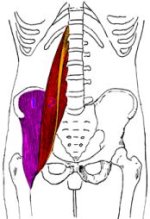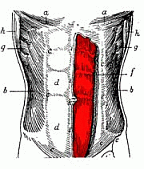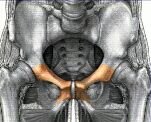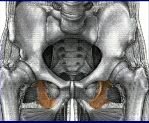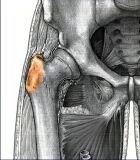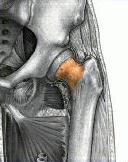DADAR
Member
You may fall into one of two categories here; the talented *natural* rider who uses these muscles without being aware of it, or the sceptic who says: You can't be serious -riding is about balance and being relaxed. Please read on; this is about those muscles that enable you to sit as though you were a part of the horse !
At this point it may help you to print the pictures out so you can look at the illustrations whilst working out how to engage these muscles!
The psoas and iliopsoas hold the torso vertical and engage to stop you from falling backwards behind the line of gravity, which passes behind the hip joints. The psoas, engaged with the rectus abdominis hold you into the centre of the saddle so that your two seat bones are connected to the horse's back muscles on either side of his spine. This is a vital piece of information, for sliding off one side or the other (usually to the outside through corners) is a major cause of horses falling out through their shoulder or haunches or “bulging”.
By engaging these muscles you centre yourself over your horse. By using the guy rope analogy you may find out which side is stronger. The guy ropes will feel taut (and supporting) on one side whilst on the other they may be sagging (unsupporting) and your body may have a tendency to collapse on this side. Therefore if your muscles on the left hand side of your body are holding you correctly over your horse's back muscle and the right hand side ones are somewhat soft your right seat bone will be floating off the back muscle leaving the horse at his discretion about where to place his haunches and / or shoulder on that side.
Thinking about the psoas and iliopsoas as guy ropes see if you can “tighten” first one side then the other. It may be easier to try this first on a stool or chair before in the saddle. Sit evenly on your seat bones and open your thighs to form a symmetrical V shape. Remembering that these muscles run from your lower rib onto your crotch and down into the hip joint, try to pull the left side of your body closer towards your mid line. If you succeed your torso should have gained a much more “solid” feel to it. Your left seat bone will become more noticeable; your thigh should seem longer and stronger. The tendon (adductor) at the top of the inside of the thigh will also become more noticeable. In the saddle this will encourage your leg to lie snugly against it. The quadriceps muscle running along the top of the lengthened thigh may start to feel the strain if you hold the position for a while.
Come back to the starting point and repeat on the other side of your body. One side of your body will probably feel very different to the other. Play around with this and see where those differences lie. Then try bringing both sides of your body in towards the mid line together. At this stage you will probably feel that you are now engaging the rectus abdominis too (and probably the lumbar area too - your "bracing the back " muscles).
The actual purpose of all this anatomical stuff is to get you to the point where, on each of your legs, the neck of the femur is laying on the long back muscle of the horse with your seat bones either side of his spine. Now you have the necessary “tools” to be able to control your horse much more effectively. But don't despair if you don't get an instant reaction. It may be something you have to work at to make sure your guy ropes are supporting you evenly on both sides at all times.
When you become connected (as one with the horse) you will understand where the phrases of the great Masters came from: "Lengthen / stretch down the inside leg" / "Weighting the inside seat bone."
Armed with this knowledge you can read the piece on turning, below, and hopefully, read between the lines as to what you do at each of the stressed points. (Once again I am grateful to Dr Thomas Ritter for allowing me to use his exact words).
Essentially, all you have to do is sit and feel what the horse is doing. Then you compare the input you get via your seat, legs and hands to your knowledge of what it should feel like. The discrepancy between the status quo and the ideal will tell you exactly what you need to do. After studying all the theory, this is what riding comes down to. Sit, feel, observe, compare, adjust. The difficulty lies in looking at the horse's gait with a powerful enough microscope, so that nothing escapes your notice. The other difficulty is to observe every single step, and to respond immediately, within the same stride, when the gait goes off course.
To stay with your example of bending the horse on a circle: If you feel that the outside hind leg is falling out, bring your outside hip and the entire leg more back, and drive the hind legs towards the inside shoulder. If the haunches swing to the inside, bring your inside leg back, and perhaps rotate your pelvis, so that your outside hip comes more forward. If the horse is stiff and does not want to bend, maybe you have to increase the spiral seat.
If the outside shoulder falls out, catch it with your outside knee and rein. If the shoulder falls into the turn, catch it with your inside knee and rein (acting against the base of the neck, rather than the mouth).
One thing that is especially important with respect to bending, that I have not found in any book, either modern or old, is that your seat is adjustable in three dimensions. Take advantage of that. Experiment with that. If your horse is resistant, and you keep adjusting your seat in all three dimensions, you will sooner or later end up with an alignment in which all the tension leaves the horse's body, because you have harmonized yourself, your own body alignment, with your horse's. That is something that is very difficult to teach, because it is so individual and often so subtle, but it is the most powerful adjustment you can make. Since we are all built differently, you cannot transfer the precise alignment from one rider to the next. You can only teach concepts and tell the student to play with them, until they figure out for themselves what works. The teacher can make suggestions concerning the alignment, and he can give feedback, but the horse's feedback is actually much greater, clearer and more impressive than anything the teacher can say.
To give you a brief example, you can adjust your hips three different ways. You can bring one hip more forward and the other one back, or vice versa. That's one dimension. You can tilt your pelvis forward or back. That's the second dimension. You can lower or raise one seat bone. That's the third dimension. The correct alignment will involve a combination of all three dimensions. The same thing applies to the shoulders. However, in my own experience, the hips are more important. Any adjustment should begin there, while the shoulders are then co-ordinated with the hips in a second step. Dr Thomas Ritter
The Tensor Fascia Latae muscles that turn the thighs inwards and open the hips
At this point it may help you to print the pictures out so you can look at the illustrations whilst working out how to engage these muscles!
The psoas and iliopsoas hold the torso vertical and engage to stop you from falling backwards behind the line of gravity, which passes behind the hip joints. The psoas, engaged with the rectus abdominis hold you into the centre of the saddle so that your two seat bones are connected to the horse's back muscles on either side of his spine. This is a vital piece of information, for sliding off one side or the other (usually to the outside through corners) is a major cause of horses falling out through their shoulder or haunches or “bulging”.
By engaging these muscles you centre yourself over your horse. By using the guy rope analogy you may find out which side is stronger. The guy ropes will feel taut (and supporting) on one side whilst on the other they may be sagging (unsupporting) and your body may have a tendency to collapse on this side. Therefore if your muscles on the left hand side of your body are holding you correctly over your horse's back muscle and the right hand side ones are somewhat soft your right seat bone will be floating off the back muscle leaving the horse at his discretion about where to place his haunches and / or shoulder on that side.
Thinking about the psoas and iliopsoas as guy ropes see if you can “tighten” first one side then the other. It may be easier to try this first on a stool or chair before in the saddle. Sit evenly on your seat bones and open your thighs to form a symmetrical V shape. Remembering that these muscles run from your lower rib onto your crotch and down into the hip joint, try to pull the left side of your body closer towards your mid line. If you succeed your torso should have gained a much more “solid” feel to it. Your left seat bone will become more noticeable; your thigh should seem longer and stronger. The tendon (adductor) at the top of the inside of the thigh will also become more noticeable. In the saddle this will encourage your leg to lie snugly against it. The quadriceps muscle running along the top of the lengthened thigh may start to feel the strain if you hold the position for a while.
Come back to the starting point and repeat on the other side of your body. One side of your body will probably feel very different to the other. Play around with this and see where those differences lie. Then try bringing both sides of your body in towards the mid line together. At this stage you will probably feel that you are now engaging the rectus abdominis too (and probably the lumbar area too - your "bracing the back " muscles).
The actual purpose of all this anatomical stuff is to get you to the point where, on each of your legs, the neck of the femur is laying on the long back muscle of the horse with your seat bones either side of his spine. Now you have the necessary “tools” to be able to control your horse much more effectively. But don't despair if you don't get an instant reaction. It may be something you have to work at to make sure your guy ropes are supporting you evenly on both sides at all times.
When you become connected (as one with the horse) you will understand where the phrases of the great Masters came from: "Lengthen / stretch down the inside leg" / "Weighting the inside seat bone."
Armed with this knowledge you can read the piece on turning, below, and hopefully, read between the lines as to what you do at each of the stressed points. (Once again I am grateful to Dr Thomas Ritter for allowing me to use his exact words).
Essentially, all you have to do is sit and feel what the horse is doing. Then you compare the input you get via your seat, legs and hands to your knowledge of what it should feel like. The discrepancy between the status quo and the ideal will tell you exactly what you need to do. After studying all the theory, this is what riding comes down to. Sit, feel, observe, compare, adjust. The difficulty lies in looking at the horse's gait with a powerful enough microscope, so that nothing escapes your notice. The other difficulty is to observe every single step, and to respond immediately, within the same stride, when the gait goes off course.
To stay with your example of bending the horse on a circle: If you feel that the outside hind leg is falling out, bring your outside hip and the entire leg more back, and drive the hind legs towards the inside shoulder. If the haunches swing to the inside, bring your inside leg back, and perhaps rotate your pelvis, so that your outside hip comes more forward. If the horse is stiff and does not want to bend, maybe you have to increase the spiral seat.
If the outside shoulder falls out, catch it with your outside knee and rein. If the shoulder falls into the turn, catch it with your inside knee and rein (acting against the base of the neck, rather than the mouth).
One thing that is especially important with respect to bending, that I have not found in any book, either modern or old, is that your seat is adjustable in three dimensions. Take advantage of that. Experiment with that. If your horse is resistant, and you keep adjusting your seat in all three dimensions, you will sooner or later end up with an alignment in which all the tension leaves the horse's body, because you have harmonized yourself, your own body alignment, with your horse's. That is something that is very difficult to teach, because it is so individual and often so subtle, but it is the most powerful adjustment you can make. Since we are all built differently, you cannot transfer the precise alignment from one rider to the next. You can only teach concepts and tell the student to play with them, until they figure out for themselves what works. The teacher can make suggestions concerning the alignment, and he can give feedback, but the horse's feedback is actually much greater, clearer and more impressive than anything the teacher can say.
To give you a brief example, you can adjust your hips three different ways. You can bring one hip more forward and the other one back, or vice versa. That's one dimension. You can tilt your pelvis forward or back. That's the second dimension. You can lower or raise one seat bone. That's the third dimension. The correct alignment will involve a combination of all three dimensions. The same thing applies to the shoulders. However, in my own experience, the hips are more important. Any adjustment should begin there, while the shoulders are then co-ordinated with the hips in a second step. Dr Thomas Ritter
The Tensor Fascia Latae muscles that turn the thighs inwards and open the hips



